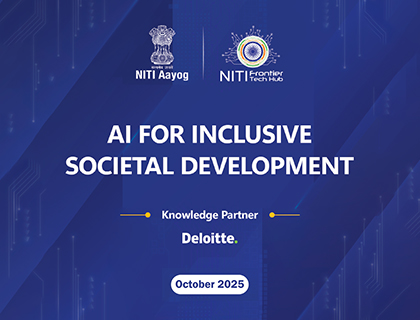Empowering Rural India: AI's Inclusive Revolution
India's rural AI initiatives aim to empower 490 million informal workers, ensuring inclusive growth through accessible technology and innovative solutions.

Empowering Rural India: AI's Inclusive Revolution
India is rapidly emerging as a global AI powerhouse, but its ambitions extend far beyond urban tech hubs. In 2025, a wave of initiatives is bringing advanced artificial intelligence—from voice assistants to predictive analytics—directly to rural and informal communities. This is not just about technology transfer; it is a deliberate strategy to ensure that India’s 490 million informal workers and rural residents are not left behind in the digital revolution. The effort is driven by government policy, academic research, and grassroots innovation, all converging to make AI a tool for social inclusion, economic empowerment, and sustainable development.
The Vision: AI for All, Not Just the Elite
At the core of India’s rural AI push is a recognition that technology must amplify, not replace, the skills of those who have historically been excluded from formal economic systems. The NITI Aayog’s October 2025 report, AI for Inclusive Societal Development, lays out a roadmap for deploying AI, IoT, blockchain, robotics, and immersive learning to dismantle systemic barriers faced by informal workers—from home healthcare aides in Rajkot to carpenters in Delhi and farmers across the country. The report emphasizes that for these communities, technology must be accessible, affordable, and relevant to their daily lives.
Digital ShramSetu Mission is the national initiative anchoring this vision. It prioritizes sector- and persona-specific solutions, state-level implementation, regulatory support, and partnerships to ensure wide adoption. By 2035, the mission envisions voice-first AI interfaces overcoming language and literacy barriers, smart contracts ensuring transparent payments, and micro-credentials enabling on-demand upskilling.
How AI is Reaching Rural India: Key Initiatives and Technologies
Language and Literacy: Breaking Down Barriers
Language is a major hurdle in a country with 22 officially recognized languages and hundreds of dialects. The Bhashini program, launched in 2022 and expanded through 2025, is building multilingual AI to ensure that language is no longer a barrier to access. IIT Madras’s AI4Bharat initiative develops open-source natural language processing (NLP) tools for underserved Indian languages, with applications in telemedicine, governance, and education. These tools are now empowering tribal and rural populations with AI-powered governance and healthcare solutions.
Sovereign AI Models: Reducing Foreign Dependence
To assert technological sovereignty, India is investing heavily in homegrown foundation models. In early 2025, Sarvam AI was selected to build the country’s first large-scale, indigenous foundation model, trained entirely in India using 4,096 government-backed NVIDIA H100 GPUs. This 70-billion-parameter model is designed for fluency in Indian languages, advanced reasoning, and deployment on low-resource devices—critical for rural settings with limited connectivity and hardware. The initiative has since expanded, with additional teams developing specialized models for language, speech, and real-time interaction, supported by a ₹1,500 crore ($174.5 million) innovation fund.
Agriculture: AI for Food Security and Sustainability
Agriculture remains the backbone of rural India, and AI is transforming this sector at an unprecedented pace. By 2025, over 40% of urban farms in Indian cities are projected to use AI-powered crop monitoring systems, and similar trends are spreading to peri-urban and rural areas. Farmers now leverage AI-managed equipment for weather forecasting, crop monitoring, and pest detection. Predictive analytics help determine optimal sowing and harvesting times, reducing losses and increasing yields. Subscription-based platforms like Farmonaut democratize access to satellite-powered insights, real-time monitoring, and blockchain-based traceability, making advanced tools affordable even for small-scale farmers.
Healthcare and Education: Bridging Gaps
India’s doctor-patient ratio is among the lowest globally. AI-powered telemedicine, diagnostics, and predictive care are closing this gap, especially in remote villages. Virtual health assistants and chatbots provide primary consultations, while AI-operated imaging technologies enable early disease detection. In education, AI tailors learning to individual student needs, supports teachers with smart lesson planning, and delivers top-tier educational content to millions in small towns and villages.
The Infrastructure: Affordable Compute and Skilling
A critical enabler of rural AI adoption is the IndiaAI Mission, which addresses key gaps by providing affordable compute power (38,000 GPUs available at just ₹65 per hour), creating a national data platform, supporting foundation models, advancing AI skilling, and ensuring safe, trustworthy AI. Twelve companies are now developing foundation models, with a national large language model slated for launch by the end of 2025. This infrastructure is designed to be accessible to startups, researchers, and rural innovators alike.
Context and Implications: Why This Matters
India’s rural AI strategy is not just a technological experiment—it is a socioeconomic imperative. By targeting the informal sector and rural populations, the country is attempting to leapfrog traditional development pathways and create a more equitable growth model. The potential economic impact is enormous: AI could contribute up to $600 billion to India’s GDP by accelerating productivity across agriculture, healthcare, education, and manufacturing.
However, challenges remain. Affordability, digital literacy, and connectivity gaps persist in many rural areas. Ensuring that AI solutions are culturally relevant, easy to use, and truly empowering—rather than displacing—local workers is essential for long-term success. The government’s multi-stakeholder approach, involving industry, academia, and civil society, aims to address these challenges through continuous feedback and impact evaluation.
The Road Ahead
India’s commitment to training AI in rural settings marks a bold departure from the centralized, urban-centric tech development seen in many countries. It reflects a belief that the benefits of AI should be universal, not exclusive. As these initiatives scale, they could offer a blueprint for other developing nations seeking to harness AI for inclusive growth.
The story of AI in rural India is still being written, but its early chapters suggest a future where technology is not a privilege of the few, but a right for the many—a future where a farmer in Punjab, a weaver in Varanasi, and a healthcare worker in Odisha all have a stake in the AI revolution.



